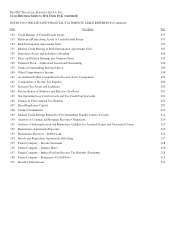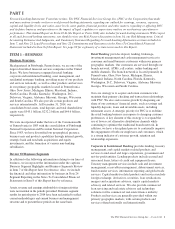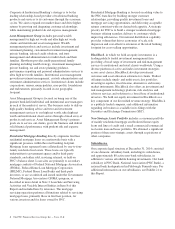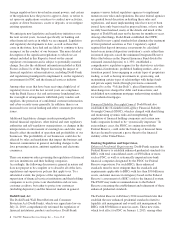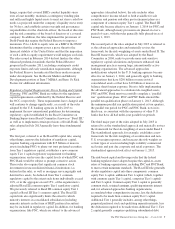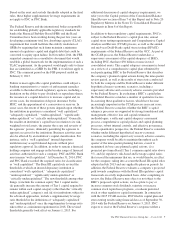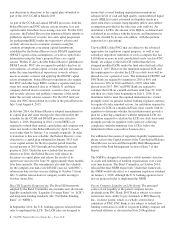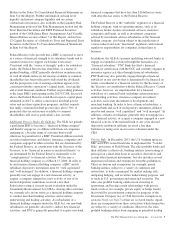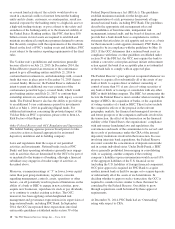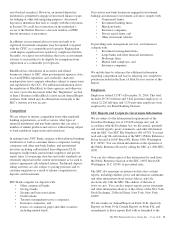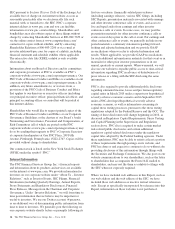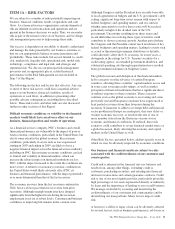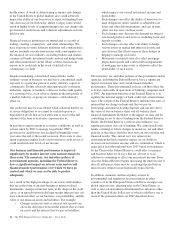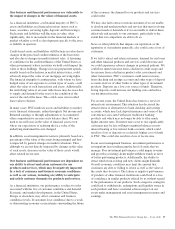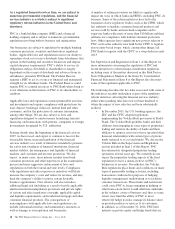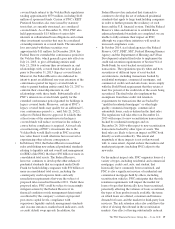PNC Bank 2014 Annual Report Download - page 27
Download and view the complete annual report
Please find page 27 of the 2014 PNC Bank annual report below. You can navigate through the pages in the report by either clicking on the pages listed below, or by using the keyword search tool below to find specific information within the annual report.
Matters in the Notes To Consolidated Financial Statements in
Item 8 of this Report. Further information on bank level
liquidity and parent company liquidity and on certain
contractual restrictions is also available in the Liquidity Risk
Management portion of the Risk Management section and the
Trust Preferred Securities and REIT Preferred Securities
portion of the Off-Balance Sheet Arrangements And Variable
Interest Entities section of Item 7 of this Report, and in Note
12 Capital Securities of a Subsidiary Trust and Perpetual Trust
Securities in the Notes To Consolidated Financial Statements
in Item 8 of this Report.
Federal Reserve rules provide that a BHC is expected to serve
as a source of financial strength to its subsidiary banks and to
commit resources to support such banks if necessary.
Consistent with the “source of strength” policy for subsidiary
banks, the Federal Reserve has stated that, as a matter of
prudent banking, a BHC generally should not maintain a rate
of cash dividends unless its net income available to common
shareholders has been sufficient to fully fund the dividends
and the prospective rate of earnings retention appears to be
consistent with the corporation’s capital needs, asset quality
and overall financial condition. Further, in providing guidance
to the large BHCs participating in the 2015 CCAR, discussed
above, the Federal Reserve stated that it expects capital plans
submitted in 2015 to reflect conservative dividend payout
ratios and net share repurchase programs, and that requests
that imply common dividend payout ratios above 30% of
projected after-tax net income available to common
shareholders will receive particularly close scrutiny.
Additional Powers Under the GLB Act. The GLB Act permits
a qualifying BHC to become a “financial holding company”
and thereby engage in, or affiliate with financial companies
engaging in, a broader range of activities than would
otherwise be permitted for a BHC. Permitted affiliates include
securities underwriters and dealers, insurance companies and
companies engaged in other activities that are determined by
the Federal Reserve, in consultation with the Secretary of the
Treasury, to be “financial in nature or incidental thereto” or
are determined by the Federal Reserve unilaterally to be
“complementary” to financial activities. We became a
financial holding company as of March 13, 2000. In order to
be and remain a financial holding company, a BHC and its
subsidiary depository institutions must be “well capitalized”
and “well managed.” In addition, a financial holding company
generally may not engage in a new financial activity, or
acquire a company engaged in a new activity, if any of its
insured depository institutions received a less than
Satisfactory rating at its most recent evaluation under the
Community Reinvestment Act (CRA). Among other activities,
we currently rely on our status as a financial holding company
to conduct merchant banking activities and securities
underwriting and dealing activities. As subsidiaries of a
financial holding company under the GLB Act, our non-bank
subsidiaries are generally allowed to conduct new financial
activities, and PNC is generally permitted to acquire non-bank
financial companies that have less than $10 billion in assets,
with after-the-fact notice to the Federal Reserve.
The Federal Reserve is the “umbrella” regulator of a financial
holding company, with its operating entities, such as its
subsidiary broker-dealers, investment advisers, insurance
companies and banks, as well as investment companies
advised by investment adviser subsidiaries of the financial
holding company, also being subject to the jurisdiction of
various federal and state “functional” regulators with normal
regulatory responsibility for companies in their lines of
business.
In addition, the GLB Act permits qualifying national banks to
engage in expanded activities through the formation of a
“financial subsidiary.” PNC Bank has filed a financial
subsidiary certification with the OCC and currently engages in
insurance agency activities through financial subsidiaries.
PNC Bank may also generally engage through a financial
subsidiary in any activity that is determined to be financial in
nature or incidental to a financial activity by the Secretary of
the Treasury, in consultation with the Federal Reserve. Certain
activities, however, are impermissible for a financial
subsidiary of a national bank, including certain insurance
underwriting activities, insurance company investment
activities, real estate investment or development, and
merchant banking. In order to have a financial subsidiary, a
national bank and each of its depository institution affiliates
must be and remain “well capitalized” and “well managed.” In
addition, a financial subsidiary generally may not engage in a
new financial activity, or acquire a company engaged in a new
financial activity, if the national bank or any of its insured
depository institution affiliates received a less than
Satisfactory rating at its most recent evaluation under the
CRA.
Volcker Rule. In December 2013, the U.S. banking agencies,
SEC and CFTC issued final rules to implement the “Volcker
Rule” provisions of Dodd-Frank. The rules prohibit banks and
their affiliates (collectively, banking entities) from trading as
principal on a short-term basis in securities, derivatives and
certain other financial instruments, but also includes several
important exclusions and exemptions from this prohibition.
These exclusions and exemptions, for example, permit
banking entities, subject to a variety of conditions and
restrictions, to trade as principal for market making, risk-
mitigating hedging, and securities underwriting purposes, and
to trade in U.S. government and municipal securities. The
rules also prohibit banking entities from investing in,
sponsoring, and having certain relationships with private
funds (such as, for example, private equity or hedge funds)
that would be an investment company for purposes of the
Investment Company Act of 1940 but for the exemptions in
sections 3(c)(1) or 3(c)(7) of that act (covered funds). Again
there are exemptions from these restrictions which themselves
are subject to a variety of conditions. Moreover, the rules
prohibit banking entities from engaging in permitted trading
The PNC Financial Services Group, Inc. – Form 10-K 9



